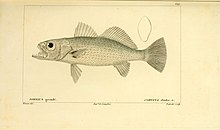Odontoscion is a genus of marine ray-finned fish belonging to the family Sciaenidae, the croakers and drums. These fishes are found in the Western Atlantic and Eastern Pacific Oceans.
| Odontoscion | |
|---|---|
 | |
| Odontoscion dentex | |
| Scientific classification | |
| Domain: | Eukaryota |
| Kingdom: | Animalia |
| Phylum: | Chordata |
| Class: | Actinopterygii |
| Order: | Acanthuriformes |
| Family: | Sciaenidae |
| Genus: | Odontoscion Gill, 1862 |
| Type species | |
| Corvina dentex | |
Taxonomy
Odontoscion was first proposed as a genus in 1862 by the American biologist Theodore Gill with its type species, and only species, designated as Corvina dentex[1] which had originally been described in 1830 by Georges Cuvier from Port-au-Prince, Haiti.[2] This genus has been placed in the subfamily Stelliferinae by some workers,[3] but the 5th edition of Fishes of the World does not recognise subfamilies within the Sciaenidae, which it places in the order Acanthuriformes.[4]
Etymology
Odontoscion is a combination of odontos, meaning teeth, a referenece to the 6 or 7 large canine-like teeth on each side of both jaws of the type species, with scion, a modern Greek name of the shi drum (Umbrina cirrosa), which Gill chose in preference to “sciaena” because he thought that it sounded better, similar to his coining of Cynoscion.[5]
Species
Odontoscion contains three valid species:[6]
- Odontoscion dentex (Cuvier, 1830) (Reef croaker)
- Odontoscion eurymesops (Heller & Snodgrass, 1903) (Galapagos croaker)
- Odontoscion xanthops Gilbert, 1898 (Yelloweye croaker)
Characteristics
Odontoscion croakers have short, rather oblong and compressed bodies,[7] with a smoothly arched dorsal profile.[8] They have a low head with a conical snout and a large eye. There is a small protuberance on the tip of the lower jaw. The mouth is moderately large, upwards pointing and has a protruding lower jaw. There is a row of large teeth in the front of each jaw, at least some of which may be canine-like. The snout has 8 pores and there are a further 4 or 5 pores on the chin, which does not have a barbel. The preoperculum is smooth. The dorsal fin is supported by 10 or 11 spines before the incision and by a single spine and between 23 and 26 soft rays to the rear of the incision, The anal fin has 2 spines and 8 or 9 soft rays, with the second spine being 75% of the length of the first soft ray.[7] These fishes have maximum published total lengths of 25 cm (9.8 in) in the case of O. eurymesops and 30 cm (12 in) in the other two species.[6]
Distribution and habitat
Odontoscion are found off the Americas with a single species, O. dentex in the Western Atlantic Ocean occurring from Florida and Cuba south to Brazil.[9] The other two species are found in the Eastern Pacific Ocean with O. eurymesops being endemic to the Galapagos Islands and Cocos Island[10][11] while O. xanthops has a range which extends from the Gulf of California to Peru.[12] One species, O. xanthops is found in shallow coastal waters and enters estuaries and the mouths of rivers,[12] the other two species refer harder substrates such as rocks and reefs.[9][10]